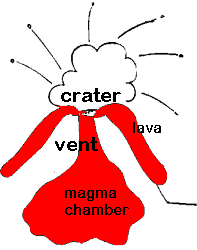BACKGROUND:
 Volcanoes are structural evidence of plate tectonics. They occur because
the Earth's crust is moving, allowing molten rock, or magma, from below to
rise through cracks in the crust to the Earth's surface. The reason why
magma rises is simple. It is less dense than the surrounding rock, so it
moves upward, just like warm air rises toward the ceiling in a room. Magma
is molten rock that has not reached the surface of the Earth.
"Lava" is molten rock that has reached the surface. When lava
cools down it forms volcanic rocks, when magma cools (without reaching the
surface) it forms plutonic rocks. Volcanic and plutonic rocks are both types
of igneous rocks.
Volcanoes are structural evidence of plate tectonics. They occur because
the Earth's crust is moving, allowing molten rock, or magma, from below to
rise through cracks in the crust to the Earth's surface. The reason why
magma rises is simple. It is less dense than the surrounding rock, so it
moves upward, just like warm air rises toward the ceiling in a room. Magma
is molten rock that has not reached the surface of the Earth.
"Lava" is molten rock that has reached the surface. When lava
cools down it forms volcanic rocks, when magma cools (without reaching the
surface) it forms plutonic rocks. Volcanic and plutonic rocks are both types
of igneous rocks.
There are many different types of volcanic and plutonic igneous rocks.
However, they all have in common that they were once molten, and have since
cooled down and become solid. Igneous rocks look different because of two
factors: (1) they have cooled at different rates and (2) the
"Mother" Magma (original melted rock) was a different composition.
Geologists then use these factors to name igneous rocks. For example, magmas
cooling at different rates develop different sized crystals. Quick cooling
(hours to years) igneous rocks have small crystals. For example, basalt has
small crystals that can be seen under a microscope, inferring that basalt
cooled quickly. Obsidian (volcanic glass) cooled so quickly that has
virtually no crystals. Magma that cools slowly (thousands to millions of
years) creates rocks with large minerals, like granite.
The parts of a volcano include a reservoir of magma inside the Earth,
called a magma chamber. The magma chamber is connected to the surface of the
Earth by a vent. The magma moves upward through the vent because it is less
dense than the surrounding rock. It breaks through the surface of the Earth
at the volcano’s crater, and may flow down its side as a lava flow. Note
that magma generally does not form in the magma chamber. This magma is
generated deeper in the mantle of the Earth, and ascends and collects in the
magma chamber.
There are several stages in the life of a volcano. An volcano is active
when lava is being extruded or the magma is moving upward from the magma
chamber. An eruption is possible in an active volcano, although it may not
have erupted recently. A dormant volcano is "sleeping". It can
become active again, when new magma rises upward within it. An extinct
volcano has no signs of becoming active. Usually the magma chamber has not
been refreshed for thousands to millions of years. Volcanoes may repeatedly
move between dormant and active phases.
PROCEDURE:
- Introduce the Plate Tectonic Cycle to the students.
You may want to use selected pictures from the Volcano (slideshow). Tell them that the
outermost portion of the Earth moves causing stress
 within the Earth's
crust. Preview the unit with them, telling them that in the upcoming
weeks they will study rocks from volcanoes, how energy waves cause
damage during an earthquake, how stress builds up in the Earth, and how
volcanic hazards can harm people.
within the Earth's
crust. Preview the unit with them, telling them that in the upcoming
weeks they will study rocks from volcanoes, how energy waves cause
damage during an earthquake, how stress builds up in the Earth, and how
volcanic hazards can harm people.
- Draw
the diagram to the right on the board. Explain the parts of a volcano.
Emphasize that plutonic rocks form underground, while volcanic rocks
cool on the surface
- Show the students samples of basalt, obsidian and granite. Basalt and
obsidian are volcanic rocks; granite is plutonic. Ask students how they
can determine this. The answer is: plutonic rocks (such as granite) cool
slowly in a relatively undisturbed environment permitting the growth of
large mineral crystals which can easily be seen by the unaided eye.
Volcanic rocks cool quickly, so the minerals do not have as much time to
form large crystals, hence you cannot see minerals in a hand specimen of
such rocks as basalt. Obsidian is essentially frozen magma; it has
cooled so fast that almost no crystals have formed. It thus looks like
dark glass. Tell the students that only basalt and obsidian come from a
volcano, granite is formed deep within the crust and upper mantle of the
Earth.